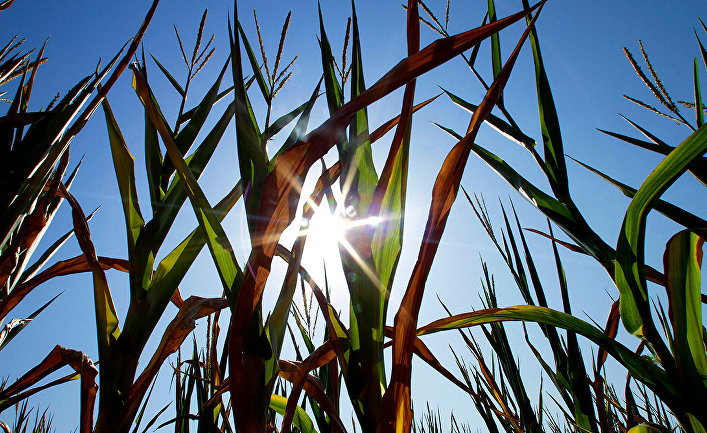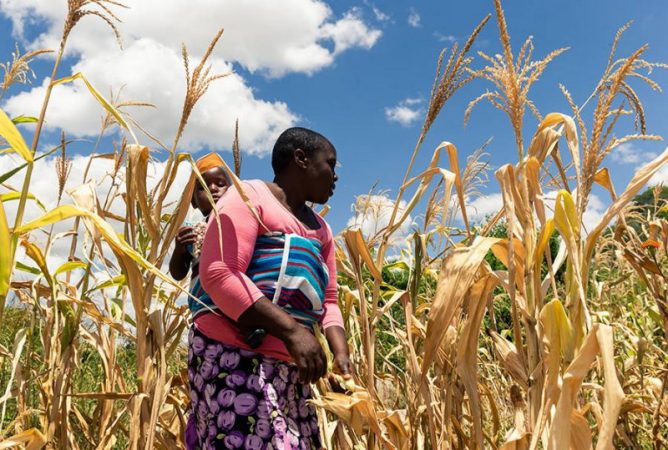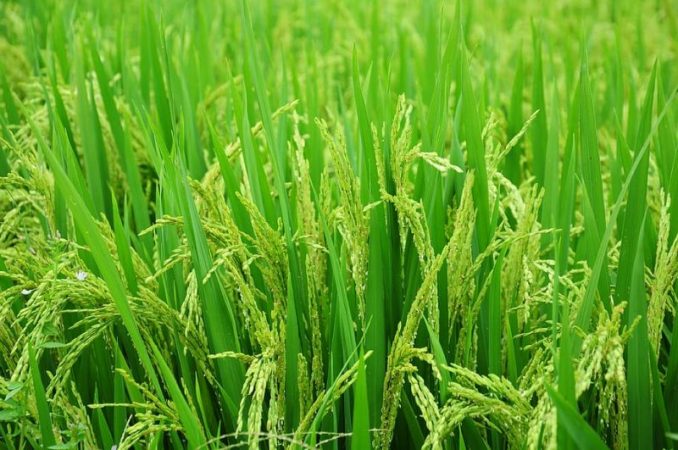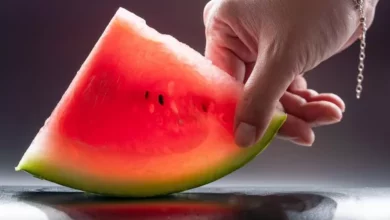
EXCLUSIVE: Changes in Earth’s atmosphere make food less healthy
(ORDO NEWS) — An article about the works of a Georgian scientist who, having arrived in the USA, in addition to mathematics, took up biology. He began to observe changes in the life of plants depending on the quality of air and light. The conclusion was ecological: the growth of carbon dioxide in the atmosphere accelerates the growth of plants, but deprives them of substances useful to humans.
Irakli Loladze is a mathematician by education, but it was in the biological laboratory that he was faced with a mystery that changed his whole life. This happened in 1998, when Loladze received his doctorate at the University of Arizona. Standing by glass containers shining with bright green algae, one biologist told Loladze and half a dozen other graduate students that scientists discovered something mysterious in zooplankton.
Zooplankton are microscopic animals swimming in the world’s oceans and lakes. They feed on algae, which are essentially tiny plants. Scientists have found that by increasing the flow of light, it is possible to accelerate the growth of algae, thereby increasing the supply of food resources for zooplankton and having a positive effect on its development. But the hopes of scientists did not materialize. When researchers began to illuminate algae more, their growth really accelerated. The tiny animals got a lot of food, but, paradoxically, at some point they were on the verge of survival. An increase in the amount of food was supposed to lead to an improvement in the quality of life of zooplankton, but in the end turned into a problem. How could this happen?

Despite the fact that formally Loladze studied at the Faculty of Mathematics, he still loved biology and could not stop thinking about the results of the study. Biologists had a rough idea of what happened. A greater amount of light caused algae to grow faster, but ultimately the content of nutrients necessary for the reproduction of zooplankton in them decreased. Accelerating the growth of algae, the researchers essentially turned them into fast food. Zooplankton got more food, but it became less nutritious, and therefore the animals began to starve.
Loladze used his mathematical background to help measure and explain the dynamics of zooplankton versus algae. Together with colleagues, he developed a model that showed the relationship between a food source and an animal that depended on it. They published the first scientific report on this subject in the year 2000. But besides this, Loladze attention was focused on the more important question of the experiment: how far can this problem go?
“I was struck by how widespread the results are,” Loladze recalled in an interview. Can the same problem affect grass and cows? And rice and people? “The moment when I started thinking about nutrition of people became a turning point for me,” the scientist said.
In a world outside the ocean, the problem is not that plants suddenly begin to receive more light: for many years now they have been consuming more and more carbon dioxide. Both are necessary for plants to grow. And if more light leads to fast-growing, but less nutritious “fast-food” algae with a poorly balanced ratio of sugar and nutrients, it would be logical to assume that an increase in carbon dioxide concentration may have the same effect. And it can affect plants all over the planet. What does this mean for those plants that we eat?
Science simply did not know what Loladze discovered. Yes, the fact of increasing the level of carbon dioxide in the atmosphere was already well known, but the scientist was struck by how little research is devoted to the effect of this phenomenon on edible plants. Over the next 17 years, continuing his mathematical career, he carefully studied the scientific literature and the data that he could find. And the results, it seemed, pointed in one direction: the fast food effect that he learned about in Arizona manifested itself in fields and forests around the world. “As CO₂ continues to grow, every leaf and every blade of grass on Earth produces more and more sugars,” Loladze explained. “We have witnessed the largest in the history of the injection of carbohydrates into the biosphere - the injection, which dilutes other nutrients in our food resources.”
The scientist published the collected data just a few years ago, and they quickly attracted the attention of a small but rather worried group of researchers who raise alarming questions about the future of our diet. Could carbon dioxide have an effect on human health that we have not yet studied? It seems that the answer is yes, and in search of evidence Loladze and other scientists had to ask the most acute scientific questions, including the following: “How difficult is it to conduct research in an area that does not exist yet?”
In agricultural research, the news that many important foods are becoming less nutritious has not become news. Measurements of fruits and vegetables show that the content of minerals, vitamins and protein in them has decreased markedly over the past 50-70 years. Researchers believe that the main reason is quite simple: when we breed and select crops, the main priority for us is a higher yield, not nutrition, while varieties that produce a larger crop (be it broccoli, tomatoes or wheat) are less nutritious.
In 2004, a thorough study of fruits and vegetables revealed that everything from protein and calcium to iron and vitamin C has declined significantly in most garden crops since 1950. The authors concluded that this is mainly due to the selection of varieties for further breeding.
Loladze, in the company of several other scientists, suspects that this is not the end of the matter, and that perhaps the atmosphere itself is changing our food. Carbon dioxide is necessary for plants as well as for people - oxygen. The level of CO₂ in the atmosphere continues to grow - in an environment of increasingly polarized discussions about climate science, it does not occur to anyone to dispute this fact. Before the industrial revolution, the concentration of carbon dioxide in the Earth’s atmosphere was about 280 ppm (parts per million, the millionth fraction is a unit of measurement of any relative values equal to 1 · 10-6 of the base indicator - approx. Ed.). Last year, this value reached the mark of 400 ppm. According to scientists, in the next half century we are likely to reach 550 ppm, which is twice as much as it was in the air.
Those who are fond of plant breeding, such dynamics may seem positive. Moreover, that is how politicians hid themselves, justifying their indifferent attitude to the consequences of climate change. Republican Lamar Smith, chairman of the US House of Representatives Committee on Science, recently argued that people should not be so worried about rising levels of carbon dioxide. According to him, this is good for plants, and what is good for plants is good for us.
“A higher concentration of carbon dioxide in our atmosphere will contribute to photosynthesis, which, in turn, will lead to an increase in plant growth,” wrote a Texas Republican. “Food will be produced in larger volumes, and their quality will become better.”
But, as the experiment with zooplankton has shown, a larger volume and better quality do not always go hand in hand. On the contrary, an inverse relationship can be established between them. Here is an explanation for this phenomenon given by the best scientists: increasing concentration of carbon dioxide accelerates photosynthesis - a process that helps plants process sunlight into food. As a result, their growth accelerates, but at the same time they also begin to absorb more carbohydrates (for example, glucose) to the detriment of other nutrients we need, such as protein, iron and zinc.
In 2002, while continuing his studies at Princeton University after defending his doctoral dissertation, Loladze published a major research article in the leading journal Trends in Ecology and Evolution, which stated that increasing carbon dioxide levels and human nutrition are inextricably linked to a global change in plant quality. In the article, Loladze complained about the lack of data: among thousands of publications about plants and increasing levels of carbon dioxide, he managed to find only one in which special attention was paid to the effect of gas on the nutrient balance in rice - a crop that billions of people rely on for crops. (An article published in 1997 deals with falling levels of zinc and iron in rice).
In his article, Loladze first showed the effect of carbon dioxide on plant quality and human nutrition. However, the scientist raised more questions than he found answers, rightly claiming that there are still many gaps in the study. If nutritional changes occur at all levels of the food chain, they need to be studied and measured.
As it turned out, the problem was partly in the research world itself. To get Loladze answers, knowledge in the field of agronomy, nutrition, and plant physiology, thoroughly flavored with mathematics, was required. The last part could be dealt with, but at that time he was just beginning his scientific career, and the departments of mathematics were not particularly interested in solving the problems of agriculture and human health. Loladze struggled to get funding for new research and at the same time continued to manically collect all the possible data already published by scientists from around the world. He went to the central part of the country, to the University of Nebraska-Lincoln, where he was offered the position of assistant chair.

The university was actively engaged in research in the field of agriculture, which gave good prospects, but Loladze was just a math teacher. As explained to him, he can continue to carry out his research if he finances them himself. But he continued to fight. When distributing grants at the Department of Biology, he was refused because his application paid too much attention to mathematics, and at the Department of Mathematics because of biology.
“Year after year, I received a refusal after a refusal,” recalls Loladze. “I was desperate.” I think people did not understand the full importance of the study.”
This question has remained overboard not only in mathematics and biology. To say that the decrease in the nutritional value of the main crops due to an increase in the concentration of carbon dioxide has been little studied is to say nothing. This phenomenon is simply not discussed neither in the field of agriculture, nor in the field of health and nutrition. Absolutely.
When our correspondents contacted nutrition experts to discuss the research topic, almost all of them were extremely surprised and asked where to find the data. One leading scientist at Johns Hopkins University replied that the question was quite interesting, but admitted that he did not know anything about it. He directed me to another specialist who also heard about this for the first time. The Academy of Nutrition and Dietetics, an association of a large number of nutrition experts, helped me get in touch with nutritionist Robin Foruman, who was also not familiar with the study.
“This is really interesting, and you are right, few people are in the know,” wrote Foruman, after reading some works on this topic. She also added that she would like to study the issue more deeply. In particular, she is interested in how even a slight increase in the amount of carbohydrates in plants can affect human health.
“We don’t know what a small change in carbohydrate content in foods can ultimately lead to,” said Foruman, noting that the general tendency to consume more starch and carbohydrates seems to have something to do with the increased incidence of diseases, food related, such as obesity and diabetes. - How much can changes in the food chain affect this? While we can’t say for sure.”
We asked Marion Nesl, a professor at New York University, to comment on this phenomenon. Nesl deals with food culture and healthcare. At first, she was rather skeptical, but promised to study in detail the available information on climate change, after which she took a different position. “You convinced me,” she wrote, also expressing concern. - It is not entirely clear whether a decrease in the nutritional value of products caused by an increase in the concentration of carbon dioxide can significantly affect human health. We need a lot more data.”
Christy Ebie, a researcher at the University of Washington, studies the link between climate change and human health. She is one of the few scientists in the United States who is interested in the possible serious consequences of changing the amount of carbon dioxide, and mentions this in her every speech.
“Too many unknowns,” Ebi says. “For example, how do you know that bread no longer has the micronutrients that were in it 20 years ago?”
According to Ebi, the connection between carbon dioxide and nutrition did not immediately become obvious to the scientific community precisely because it took them quite a while to begin to seriously consider the interaction of climate and human health in general. “That’s exactly what it usually looks like,” says Ebi, “in anticipation of change.”
In the early work of Loladze, serious questions were posed, which are difficult, but quite realistic to find answers. How does increasing atmospheric CO₂ affect plant growth? What is the proportion of carbon dioxide influence on the decrease in the nutritional value of products in relation to the share of other factors, for example, growing conditions?
An experiment on a farm scale to find out how carbon dioxide affects plants is also a difficult but feasible task. Researchers use a method that turns the field into a real laboratory. To date, the perfect example is the experiment “Enrichment of carbon dioxide in the open air” (free-air carbon dioxide enrichment, in abbreviated form - FACE). In the course of this experiment, scientists in the open air create large-scale devices that spray carbon dioxide on plants in a specific area. Small sensors track CO₂ levels. When too much carbon dioxide goes out of the field, a special device sprays a new portion so that the level remains constant. Scientists can then directly compare these plants with those grown under normal conditions.
Similar experiments showed that plants growing under conditions of high carbon dioxide content undergo significant changes. So, the group of C3 plants, which includes almost 95% of the Earth’s plants, including those that we eat (wheat, rice, barley and potatoes), showed a decrease in the amount of important minerals - calcium, sodium, zinc and iron. According to forecasts of the reaction of plants to changes in carbon dioxide concentration already, in the near future the amount of these minerals will decrease by an average of 8%. The same data indicate a decrease, sometimes quite substantial, of the protein content in C3 cultures - in wheat and rice by 6% and 8%, respectively.
This summer, a group of scientists published the first works in which attempts were made to assess the impact of these changes on the world’s population. Plants are the most important source of protein for people in the developing world. According to researchers, by 2050, 150 million people are at risk of protein shortages, especially in countries such as India and Bangladesh. Scientists also found that 138 million would be at risk due to a decrease in the amount of zinc vital for mother and baby health. According to their estimates, more than 1 billion mothers and 354 million children live in countries that are projected to decrease the amount of iron in their food, which could exacerbate the already serious risk of widespread anemia.
Such forecasts have not yet touched the United States, where the diet of most of the population is diverse and contains enough protein. However, researchers note an increase in the amount of sugar in plants and fear that if these rates continue, then obese and problems with the cardiovascular system will become even greater.
The U.S. Department of Agriculture is also making a significant contribution to the study of the association of carbon dioxide with plant nutrition. Lewis Ziska, a plant physiologist at the Agricultural Research Service in Beltsville, Maryland, wrote a number of nutritional studies that examined in detail some of the questions posed by Loladze 15 years ago.
Ziska developed a simpler experiment that did not require growing plants. He decided to study the nutrition of bees.
Goldenrod is a wildflower that many consider to be a weed, but it is extremely important for bees. It blooms in late summer, and its pollen is an important source of protein for these insects during harsh winters. People have never specifically grown goldenrod or create new varieties, so over time it has not changed much, unlike corn or wheat. In the huge archives of the Smithsonian Institution, hundreds of samples of goldenrod are stored, the earliest dated in 1842. This allowed Ziska and his colleagues to track how the plant has changed since then.
Researchers have found that since the Industrial Revolution, the content of protein in goldenrod pollen has decreased by a third, and this drop is closely associated with an increase in carbon dioxide concentration. Scientists have long been trying to find out the reasons for the decline in bee populations around the world - this can badly affect the crops for pollination of which they are needed. In his work, Ziska suggested that reducing protein in pollen before winter could be another reason why bees find it difficult to survive in the winter.
The scientist is worried that the effect of carbon dioxide on plants is being studied at an insufficient speed, given that changing agricultural methods can take a long time. “We still do not have the opportunity to intervene and start using traditional methods to correct the situation,” Ziska said. “It will take 15-20 years for the results of laboratory tests to be put into practice.”
As Loladze and colleagues found out, new comprehensive cross-cutting issues can be quite complex. There are many plant physiologists in the world studying crops, but they are mostly focused on research on factors such as productivity and pest control. This has nothing to do with nutrition. According to the experience of Loladze, the departments of mathematics are not particularly interested in food products as objects of study. Studying living plants is a long and expensive business: in order to get enough data during the FACE experiment, it will take several years and serious funding.
Despite the difficulties, scientists are more and more interested in these questions, and in the next few years they may be able to find answers to them. Ziska and Loladze, who teaches mathematics at Brian College of Medical Sciences in Lincoln, Nebraska, together with a group of scientists from China, Japan, Australia and the United States are working on a major study of the effects of carbon dioxide on the nutritional properties of rice, one of the most important crops. In addition, they study the change in the amount of vitamins, important food components, which until now has not been practically done.
Recently, researchers from the US Department of Agriculture conducted another experiment. In order to find out how a higher level of CO₂ affects crops, they took samples of rice, wheat and soybeans from the 1950s and 1960s and planted them in areas where many scientists had grown the same varieties many years ago.

On the research field of the US Department of Agriculture in Maryland, scientists are experimenting with bell pepper. They want to determine how the amount of vitamin C changes with an increased concentration of carbon dioxide. They also study coffee to see if caffeine is reduced. “There are still many questions,” Ziska shared, showing the research facility in Beltsville. “This is just the beginning.”
Lewis Ziska is a member of a small group of scientists who are trying to evaluate changes and find out how they will affect a person. Another key character in this story is Samuel Myers, a climatologist at Harvard University. Myers leads the Planetary Health Alliance. The organization’s goal is to reunite climatology and healthcare. Myers is convinced that the scientific community is not paying enough attention to the relationship between carbon dioxide and nutrition, which is only part of a much larger picture of how these changes will affect the ecosystem. “This is just the tip of the iceberg,” Myers says. “We hardly made people understand how many questions they should have.”
In 2014, Myers, together with a group of scientists, published a major study in the journal Nature, which examined key crops grown in several plots in Japan, Australia, and the United States. In their composition, a decrease in the amount of protein, iron and zinc was observed due to an increase in the concentration of carbon dioxide. For the first time, the publication attracted real media attention.
“It is difficult to predict how global climate change will affect human health, but we are ready for the unexpected. One of them is the relationship of increasing the concentration of carbon dioxide in the atmosphere and reducing the nutritional value of C3 crops. Now we know about it and can predict the further development of events,” the researchers write.
In the same year, on the same day, Loladze, who at that time was teaching mathematics at the Catholic University of Daegu in South Korea, published his own article - with data that he had been collecting for more than 15 years. This is the largest study of increasing CO₂ concentration and its effect on plant nutrition. Loladze usually describes the science of plants as “noisy” - as in scientific jargon, scientists call an area in which there are a lot of complex disparate data that seems to “make noise,” and through this “noise” it is impossible to hear the signal you are looking for. His new data layer finally turned out to be large enough to recognize the desired signal through the noise and detect the “hidden shift”, as the scientist called it.
Loladze discovered that his theory of 2002, or rather the strong suspicion that he expressed then, turned out to be true. The study involved nearly 130 plant varieties and more than 15,000 samples obtained in experiments over the past 30 years. The total concentration of minerals such as calcium, magnesium, sodium, zinc and iron fell by an average of 8%. The amount of carbohydrates relative to the amount of minerals increased. Plants, like algae, became fast food.
It remains to be seen how this discovery will affect a person whose main diet is plants. Scientists who are immersed in this topic will have to overcome various obstacles: the slow pace and invisibility of research, the world of politics, where the word “climate” is enough to stop any conversation about financing. It will be necessary to build completely new “bridges” in the world of science - this is what Loladze says with a grin in his work. When the article was finally published in 2014, Loladze included in the appendix a list of all funding denials.
—
Online:
Contact us: [email protected]
Our Standards, Terms of Use: Standard Terms And Conditions.








